人教版(2019)必修第一册Unit 5 Languages around the world课后阅读课件 (19张ppt)
文档属性
| 名称 | 人教版(2019)必修第一册Unit 5 Languages around the world课后阅读课件 (19张ppt) |  | |
| 格式 | pptx | ||
| 文件大小 | 1.3MB | ||
| 资源类型 | 教案 | ||
| 版本资源 | 人教版(2019) | ||
| 科目 | 英语 | ||
| 更新时间 | 2022-11-18 19:46:32 | ||
图片预览

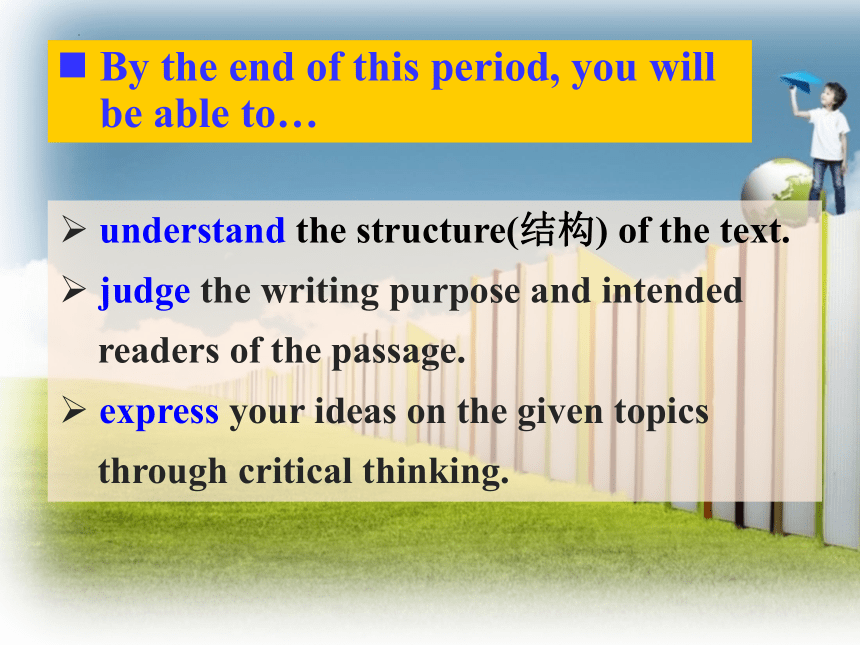
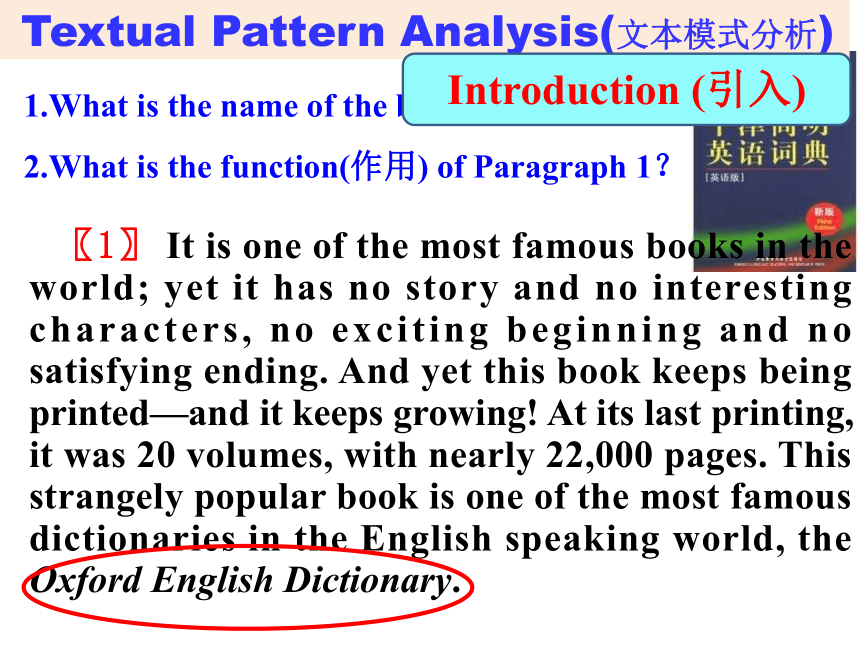
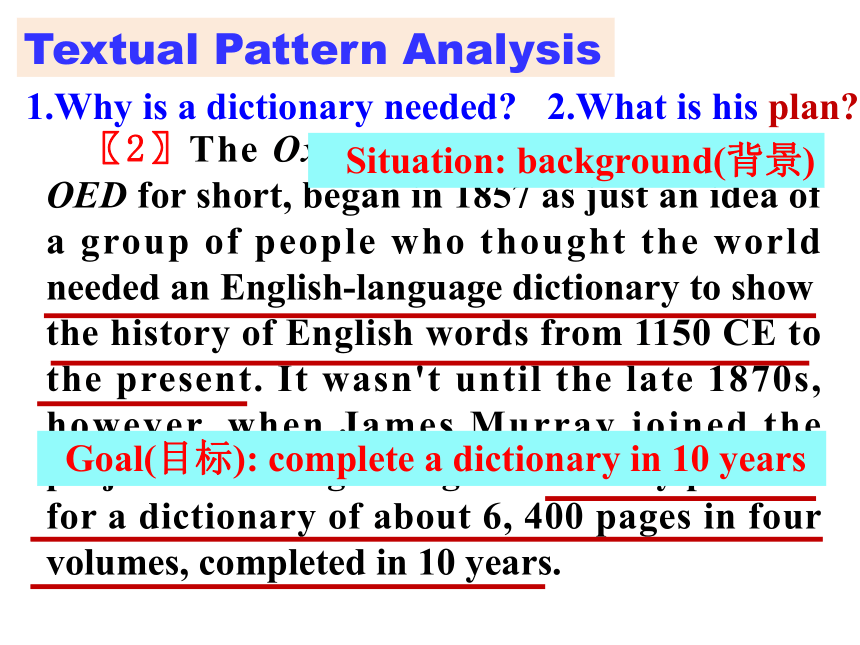
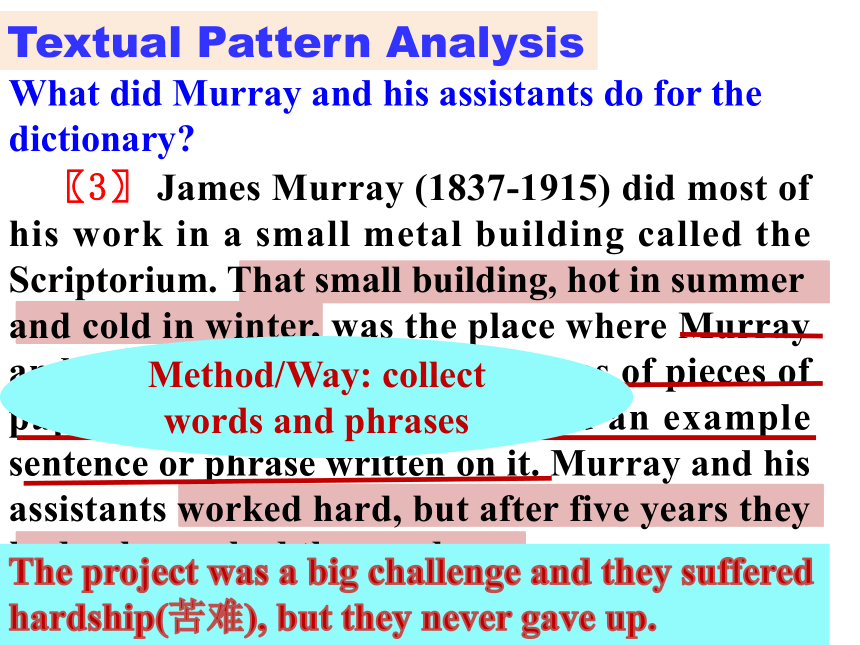
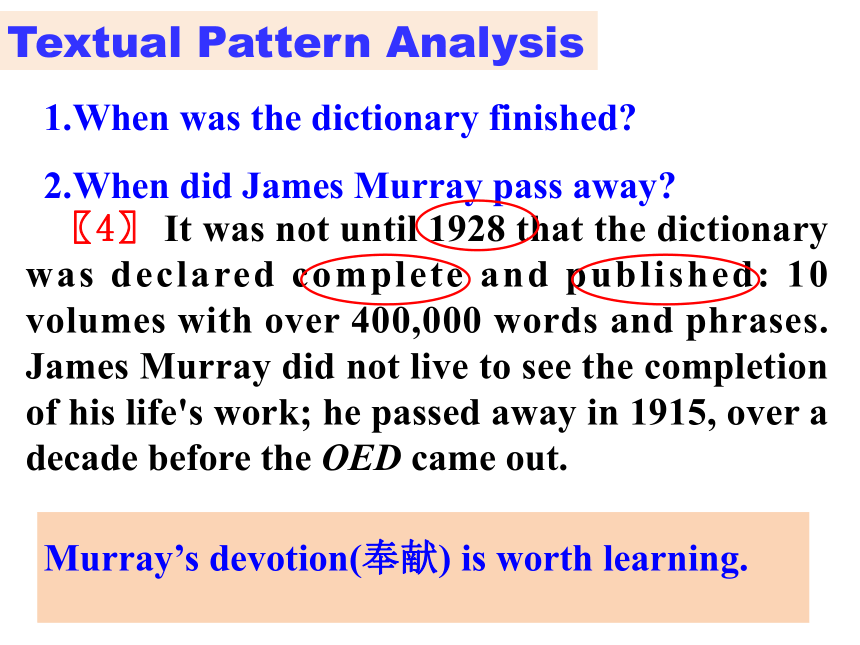
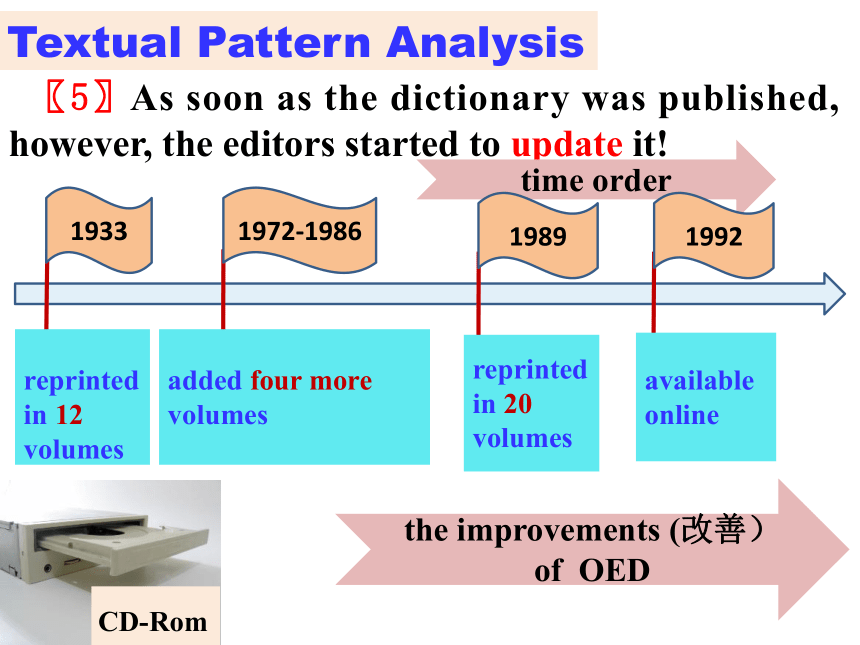
文档简介
(共19张PPT)
THE BOOK
THAT KEEPS ON GROWING
Topic
understand the structure(结构) of the text.
judge the writing purpose and intended
readers of the passage.
express your ideas on the given topics
through critical thinking.
By the end of this period, you will be able to…
Textual Pattern Analysis(文本模式分析)
〖1〗 It is one of the most famous books in the world; yet it has no story and no interesting characters, no exciting beginning and no satisfying ending. And yet this book keeps being printed—and it keeps growing! At its last printing, it was 20 volumes, with nearly 22,000 pages. This strangely popular book is one of the most famous dictionaries in the English speaking world, the Oxford English Dictionary.
1.What is the name of the book?
2.What is the function(作用) of Paragraph 1?
Introduction (引入)
Textual Pattern Analysis
〖2〗The Oxford English Dictionary, or OED for short, began in 1857 as just an idea of a group of people who thought the world needed an English-language dictionary to show the history of English words from 1150 CE to the present. It wasn't until the late 1870s, however, when James Murray joined the project that it began to grow. Murray planned for a dictionary of about 6, 400 pages in four volumes, completed in 10 years.
1.Why is a dictionary needed
Situation: background(背景)
2.What is his plan
Goal(目标): complete a dictionary in 10 years
Textual Pattern Analysis
〖3〗 James Murray (1837-1915) did most of his work in a small metal building called the Scriptorium. That small building, hot in summer and cold in winter, was the place where Murray and his assistants collected millions of pieces of paper, each one with a word and an example sentence or phrase written on it. Murray and his assistants worked hard, but after five years they had only reached the word ant.
What did Murray and his assistants do for the dictionary
The project was a big challenge and they suffered hardship(苦难), but they never gave up.
Method/Way: collect words and phrases
Textual Pattern Analysis
〖4〗 It was not until 1928 that the dictionary was declared complete and published: 10 volumes with over 400,000 words and phrases. James Murray did not live to see the completion of his life's work; he passed away in 1915, over a decade before the OED came out.
1.When was the dictionary finished
2.When did James Murray pass away
Murray’s devotion(奉献) is worth learning.
Textual Pattern Analysis
〖5〗As soon as the dictionary was published, however, the editors started to update it!
reprinted in 12 volumes
added four more volumes
reprinted in 20 volumes
available online
time order
the improvements (改善)
of OED
1933
1972-1986
1989
1992
CD-Rom
Textual Pattern Analysis
〖4〗 It was not until 1928 that the dictionary was declared complete and published: 10 volumes with over 400,000 words and phrases. James Murray did not live to see the completion of his life's work; he passed away in 1915, over a decade before the OED came out.
〖5〗As soon as the dictionary was published, however, the editors started to update it! ...
Result/achievement:
complete, publish and update the OED
Textual Pattern Analysis
〖6〗With about 600,000 words and three million quotations(引语) from over 1,000 years of English, the OED not only is a record of where the English language has come from but has also become an important part of the history of English-speaking cultures around the world.
Evaluation/comment(评价):
the importance of the OED
What is the comment on the OED
1
Situation and Goal
(plan a dictionary)
Method
(collect millions of pieces of paper)
Result
(Para.4 complete and publish
the OED
Para.5 update the OED )
Textual Pattern Analysis
2
3
4
Introduction
(a book)
5
6
Evaluation
(significance of the OED)
Goal-Achievement pattern
目标-实现模式
Result:
*completed, published
*update, add new vocabulary
*available online
Situation and Goal:
Introduction:
*began an idea
*the world needed a dictionary
*James Murray joined
*planned a dictionary completed in 10 years
*the Oxford English Dictionary
*a strangely popular book
*keep being printed
Method:
2
*a small metal building, hot and cold
*collected millions of pieces
*five years, only reached ant
3
4&5
1
Evaluation
Topic-Related Lexis/vocabulary
* not only a record,
* but also a part of history, culture
6
Who is the passage written for
Readers: to English learners.
What is the purpose of this passage
Purpose: to tell us the history and improvements about the OED.
Pragmatic Analysis(语用分析)
A dictionary of a living language is never truly finished. Many Chinese words have appeared in the Oxford English Dictionary, such as, Confucianism (孔子学说,儒家学说 P416), fengshui (风水P742). With the popularity of Chinese action movie, TaiChi (太极P2055), Kung Fu (功夫 P1124), are known to the world. This means China is developing quickly and Chinese is having an important effect on world languages.
Cultural interaction(交融)
Critical thinking
Recently, China’s new hot words, tuhao, Dama, catch the attention of the dictionary’s editing team. It is expected that they may appear in next year’s OED. What’s your opinion List your reasons.
1.opinion
2.reason
I’m in favor of/support this idea.
I think they should be included.
(2) I am against the idea.
I don’t think it is a good idea to include
such words.
(1) It can not only…but also…
(2) For one thing…, for another…
Recently, China’s new hot words, tuhao, Dama, catch the attention of the dictionary’s editing team. It is expected that they may appear in next year’s OED. What’s your opinion List your reasons.
Voice your opinion
I think the two words can be included in the OED.
They can not only reflect(反应) Chinese culture and spread Chinese, but also make more and more people know China and it’s culture.
I don’t think it’s a good idea to include such two words.
For one thing, when we use Tuhao, we describe someone who spend money in an unreasonable way, so it's not a good word in Chinese. For another, it is not as formal as other chinese words.
My opinion
Assignment
Recently, the editing team of the Oxford English Dictionary wants to update the dictionary. As a dictionary user, you can recommend some new popular words to them. So write an article about your suggestions and reasons. (about 80 words)
Reflection
figure out the structure of the text.
judge the writing purpose and intended
readers of the passage.
express your ideas on the given topics
through critical thinking.
Goal-Achievement pattern
To tell us the history and improvements about the OED.
To English learners.
Have a nice day!
THE BOOK
THAT KEEPS ON GROWING
Topic
understand the structure(结构) of the text.
judge the writing purpose and intended
readers of the passage.
express your ideas on the given topics
through critical thinking.
By the end of this period, you will be able to…
Textual Pattern Analysis(文本模式分析)
〖1〗 It is one of the most famous books in the world; yet it has no story and no interesting characters, no exciting beginning and no satisfying ending. And yet this book keeps being printed—and it keeps growing! At its last printing, it was 20 volumes, with nearly 22,000 pages. This strangely popular book is one of the most famous dictionaries in the English speaking world, the Oxford English Dictionary.
1.What is the name of the book?
2.What is the function(作用) of Paragraph 1?
Introduction (引入)
Textual Pattern Analysis
〖2〗The Oxford English Dictionary, or OED for short, began in 1857 as just an idea of a group of people who thought the world needed an English-language dictionary to show the history of English words from 1150 CE to the present. It wasn't until the late 1870s, however, when James Murray joined the project that it began to grow. Murray planned for a dictionary of about 6, 400 pages in four volumes, completed in 10 years.
1.Why is a dictionary needed
Situation: background(背景)
2.What is his plan
Goal(目标): complete a dictionary in 10 years
Textual Pattern Analysis
〖3〗 James Murray (1837-1915) did most of his work in a small metal building called the Scriptorium. That small building, hot in summer and cold in winter, was the place where Murray and his assistants collected millions of pieces of paper, each one with a word and an example sentence or phrase written on it. Murray and his assistants worked hard, but after five years they had only reached the word ant.
What did Murray and his assistants do for the dictionary
The project was a big challenge and they suffered hardship(苦难), but they never gave up.
Method/Way: collect words and phrases
Textual Pattern Analysis
〖4〗 It was not until 1928 that the dictionary was declared complete and published: 10 volumes with over 400,000 words and phrases. James Murray did not live to see the completion of his life's work; he passed away in 1915, over a decade before the OED came out.
1.When was the dictionary finished
2.When did James Murray pass away
Murray’s devotion(奉献) is worth learning.
Textual Pattern Analysis
〖5〗As soon as the dictionary was published, however, the editors started to update it!
reprinted in 12 volumes
added four more volumes
reprinted in 20 volumes
available online
time order
the improvements (改善)
of OED
1933
1972-1986
1989
1992
CD-Rom
Textual Pattern Analysis
〖4〗 It was not until 1928 that the dictionary was declared complete and published: 10 volumes with over 400,000 words and phrases. James Murray did not live to see the completion of his life's work; he passed away in 1915, over a decade before the OED came out.
〖5〗As soon as the dictionary was published, however, the editors started to update it! ...
Result/achievement:
complete, publish and update the OED
Textual Pattern Analysis
〖6〗With about 600,000 words and three million quotations(引语) from over 1,000 years of English, the OED not only is a record of where the English language has come from but has also become an important part of the history of English-speaking cultures around the world.
Evaluation/comment(评价):
the importance of the OED
What is the comment on the OED
1
Situation and Goal
(plan a dictionary)
Method
(collect millions of pieces of paper)
Result
(Para.4 complete and publish
the OED
Para.5 update the OED )
Textual Pattern Analysis
2
3
4
Introduction
(a book)
5
6
Evaluation
(significance of the OED)
Goal-Achievement pattern
目标-实现模式
Result:
*completed, published
*update, add new vocabulary
*available online
Situation and Goal:
Introduction:
*began an idea
*the world needed a dictionary
*James Murray joined
*planned a dictionary completed in 10 years
*the Oxford English Dictionary
*a strangely popular book
*keep being printed
Method:
2
*a small metal building, hot and cold
*collected millions of pieces
*five years, only reached ant
3
4&5
1
Evaluation
Topic-Related Lexis/vocabulary
* not only a record,
* but also a part of history, culture
6
Who is the passage written for
Readers: to English learners.
What is the purpose of this passage
Purpose: to tell us the history and improvements about the OED.
Pragmatic Analysis(语用分析)
A dictionary of a living language is never truly finished. Many Chinese words have appeared in the Oxford English Dictionary, such as, Confucianism (孔子学说,儒家学说 P416), fengshui (风水P742). With the popularity of Chinese action movie, TaiChi (太极P2055), Kung Fu (功夫 P1124), are known to the world. This means China is developing quickly and Chinese is having an important effect on world languages.
Cultural interaction(交融)
Critical thinking
Recently, China’s new hot words, tuhao, Dama, catch the attention of the dictionary’s editing team. It is expected that they may appear in next year’s OED. What’s your opinion List your reasons.
1.opinion
2.reason
I’m in favor of/support this idea.
I think they should be included.
(2) I am against the idea.
I don’t think it is a good idea to include
such words.
(1) It can not only…but also…
(2) For one thing…, for another…
Recently, China’s new hot words, tuhao, Dama, catch the attention of the dictionary’s editing team. It is expected that they may appear in next year’s OED. What’s your opinion List your reasons.
Voice your opinion
I think the two words can be included in the OED.
They can not only reflect(反应) Chinese culture and spread Chinese, but also make more and more people know China and it’s culture.
I don’t think it’s a good idea to include such two words.
For one thing, when we use Tuhao, we describe someone who spend money in an unreasonable way, so it's not a good word in Chinese. For another, it is not as formal as other chinese words.
My opinion
Assignment
Recently, the editing team of the Oxford English Dictionary wants to update the dictionary. As a dictionary user, you can recommend some new popular words to them. So write an article about your suggestions and reasons. (about 80 words)
Reflection
figure out the structure of the text.
judge the writing purpose and intended
readers of the passage.
express your ideas on the given topics
through critical thinking.
Goal-Achievement pattern
To tell us the history and improvements about the OED.
To English learners.
Have a nice day!
